1998 OPEL FRONTERA display
[x] Cancel search: displayPage 2290 of 6000
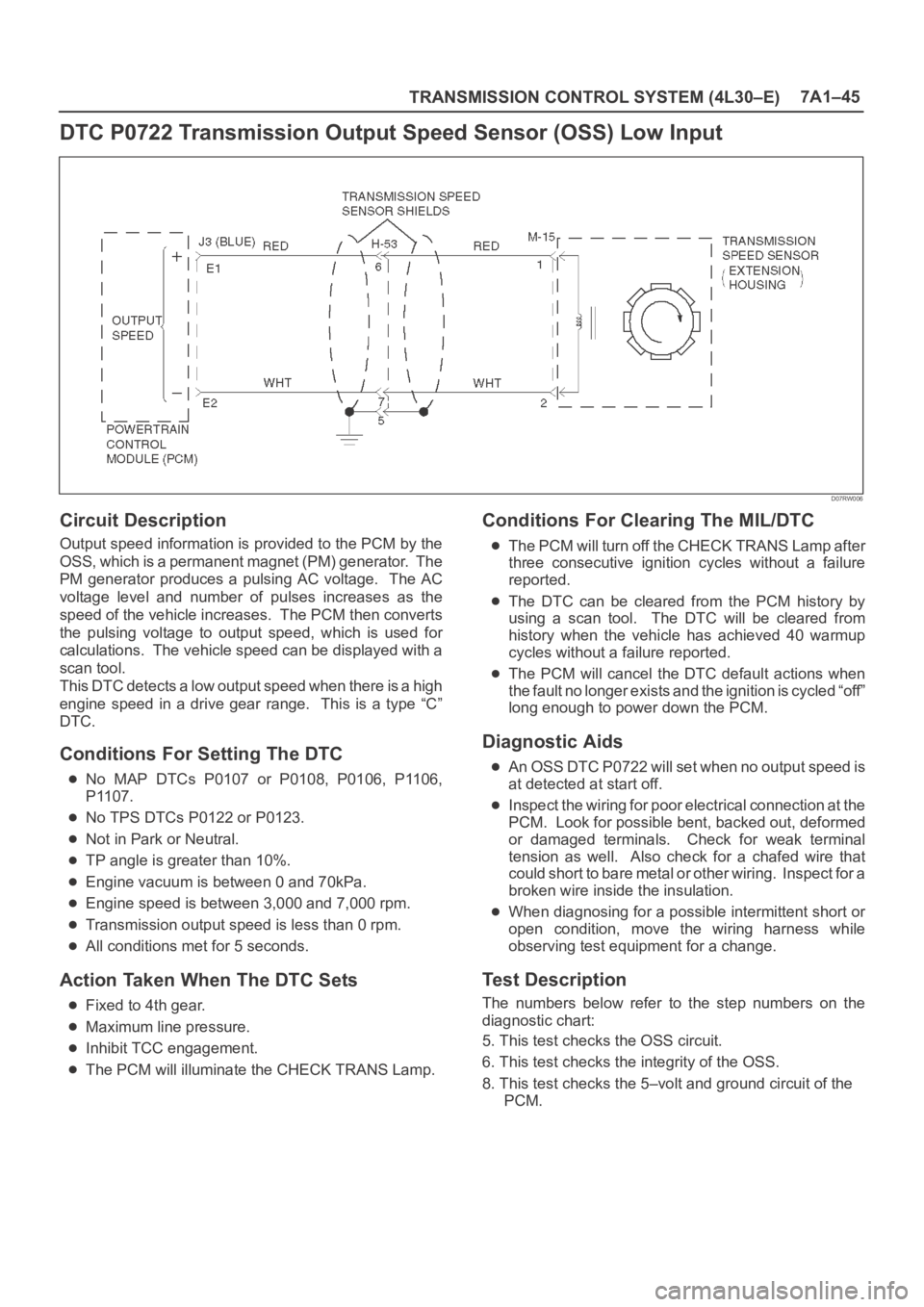
TRANSMISSION CONTROL SYSTEM (4L30–E)7A1–45
DTC P0722 Transmission Output Speed Sensor (OSS) Low Input
D07RW006
Circuit Description
Output speed information is provided to the PCM by the
OSS, which is a permanent magnet (PM) generator. The
PM generator produces a pulsing AC voltage. The AC
voltage level and number of pulses increases as the
speed of the vehicle increases. The PCM then converts
the pulsing voltage to output speed, which is used for
calculations. The vehicle speed can be displayed with a
scan tool.
This DTC detects a low output speed when there is a high
engine speed in a drive gear range. This is a type “C”
DTC.
Conditions For Setting The DTC
No MAP DTCs P0107 or P0108, P0106, P1106,
P1107.
No TPS DTCs P0122 or P0123.
Not in Park or Neutral.
TP angle is greater than 10%.
Engine vacuum is between 0 and 70kPa.
Engine speed is between 3,000 and 7,000 rpm.
Transmission output speed is less than 0 rpm.
All conditions met for 5 seconds.
Action Taken When The DTC Sets
Fixed to 4th gear.
Maximum line pressure.
Inhibit TCC engagement.
The PCM will illuminate the CHECK TRANS Lamp.
Conditions For Clearing The MIL/DTC
The PCM will turn off the CHECK TRANS Lamp after
three consecutive ignition cycles without a failure
reported.
The DTC can be cleared from the PCM history by
using a scan tool. The DTC will be cleared from
history when the vehicle has achieved 40 warmup
cycles without a failure reported.
The PCM will cancel the DTC default actions when
the fault no longer exists and the ignition is cycled “off”
long enough to power down the PCM.
Diagnostic Aids
An OSS DTC P0722 will set when no output speed is
at detected at start off.
Inspect the wiring for poor electrical connection at the
PCM. Look for possible bent, backed out, deformed
or damaged terminals. Check for weak terminal
tension as well. Also check for a chafed wire that
could short to bare metal or other wiring. Inspect for a
broken wire inside the insulation.
When diagnosing for a possible intermittent short or
open condition, move the wiring harness while
observing test equipment for a change.
Test Description
The numbers below refer to the step numbers on the
diagnostic chart:
5. This test checks the OSS circuit.
6. This test checks the integrity of the OSS.
8. This test checks the 5–volt and ground circuit of the
PCM.
Page 2292 of 6000
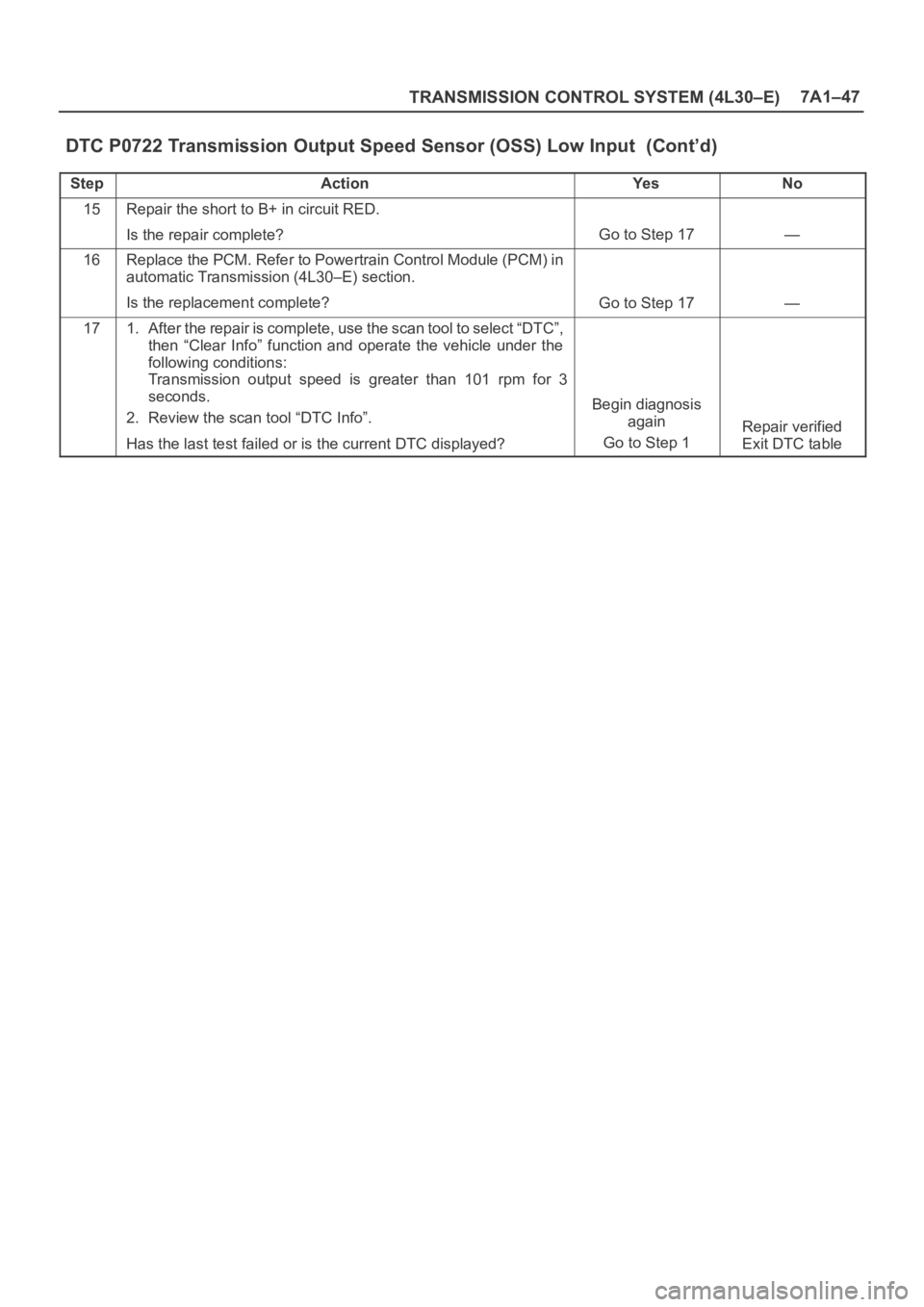
TRANSMISSION CONTROL SYSTEM (4L30–E)7A1–47
DTC P0722 Transmission Output Speed Sensor (OSS) Low Input (Cont’d)
StepNo Ye s Action
15Repair the short to B+ in circuit RED.
Is the repair complete?
Go to Step 17—
16Replace the PCM. Refer to Powertrain Control Module (PCM) in
automatic Transmission (4L30–E) section.
Is the replacement complete?
Go to Step 17—
171. After the repair is complete, use the scan tool to select “DTC”,
then “Clear Info” function and operate the vehicle under the
following conditions:
Transmission output speed is greater than 101 rpm for 3
seconds.
2. Review the scan tool “DTC Info”.
Has the last test failed or is the current DTC displayed?
Begin diagnosis
again
Go to Step 1
Repair verified
Exit DTC table
Page 2293 of 6000
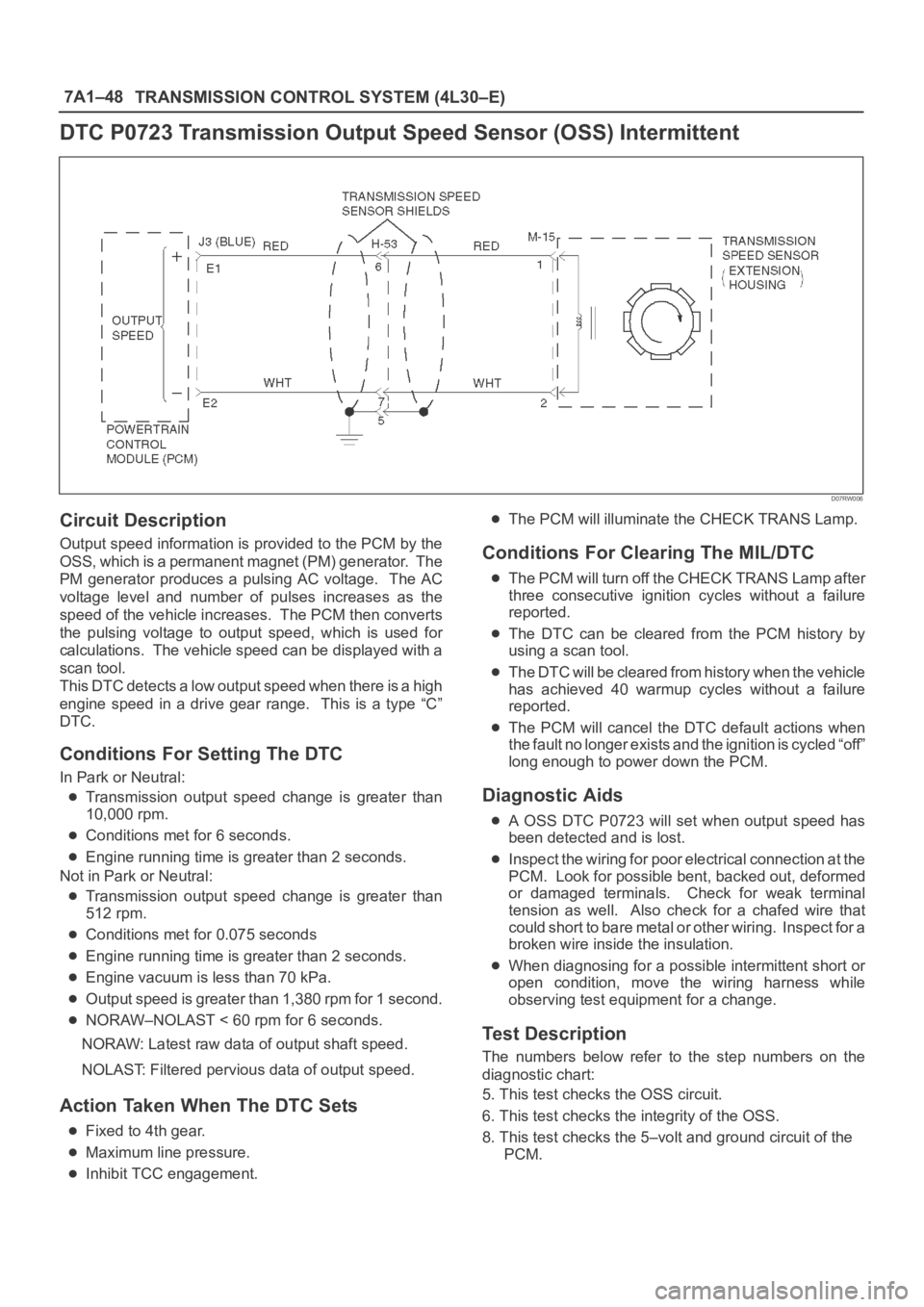
7A1–48
TRANSMISSION CONTROL SYSTEM (4L30–E)
DTC P0723 Transmission Output Speed Sensor (OSS) Intermittent
D07RW006
Circuit Description
Output speed information is provided to the PCM by the
OSS, which is a permanent magnet (PM) generator. The
PM generator produces a pulsing AC voltage. The AC
voltage level and number of pulses increases as the
speed of the vehicle increases. The PCM then converts
the pulsing voltage to output speed, which is used for
calculations. The vehicle speed can be displayed with a
scan tool.
This DTC detects a low output speed when there is a high
engine speed in a drive gear range. This is a type “C”
DTC.
Conditions For Setting The DTC
In Park or Neutral:
Transmission output speed change is greater than
10,000 rpm.
Conditions met for 6 seconds.
Engine running time is greater than 2 seconds.
Not in Park or Neutral:
Transmission output speed change is greater than
512 rpm.
Conditions met for 0.075 seconds
Engine running time is greater than 2 seconds.
Engine vacuum is less than 70 kPa.
Output speed is greater than 1,380 rpm for 1 second.
NORAW–NOLAST < 60 rpm for 6 seconds.
NORAW: Latest raw data of output shaft speed.
NOLAST: Filtered pervious data of output speed.
Action Taken When The DTC Sets
Fixed to 4th gear.
Maximum line pressure.
Inhibit TCC engagement.
The PCM will illuminate the CHECK TRANS Lamp.
Conditions For Clearing The MIL/DTC
The PCM will turn off the CHECK TRANS Lamp after
three consecutive ignition cycles without a failure
reported.
The DTC can be cleared from the PCM history by
using a scan tool.
The DTC will be cleared from history when the vehicle
has achieved 40 warmup cycles without a failure
reported.
The PCM will cancel the DTC default actions when
the fault no longer exists and the ignition is cycled “off”
long enough to power down the PCM.
Diagnostic Aids
A OSS DTC P0723 will set when output speed has
been detected and is lost.
Inspect the wiring for poor electrical connection at the
PCM. Look for possible bent, backed out, deformed
or damaged terminals. Check for weak terminal
tension as well. Also check for a chafed wire that
could short to bare metal or other wiring. Inspect for a
broken wire inside the insulation.
When diagnosing for a possible intermittent short or
open condition, move the wiring harness while
observing test equipment for a change.
Test Description
The numbers below refer to the step numbers on the
diagnostic chart:
5. This test checks the OSS circuit.
6. This test checks the integrity of the OSS.
8. This test checks the 5–volt and ground circuit of the
PCM.
Page 2295 of 6000
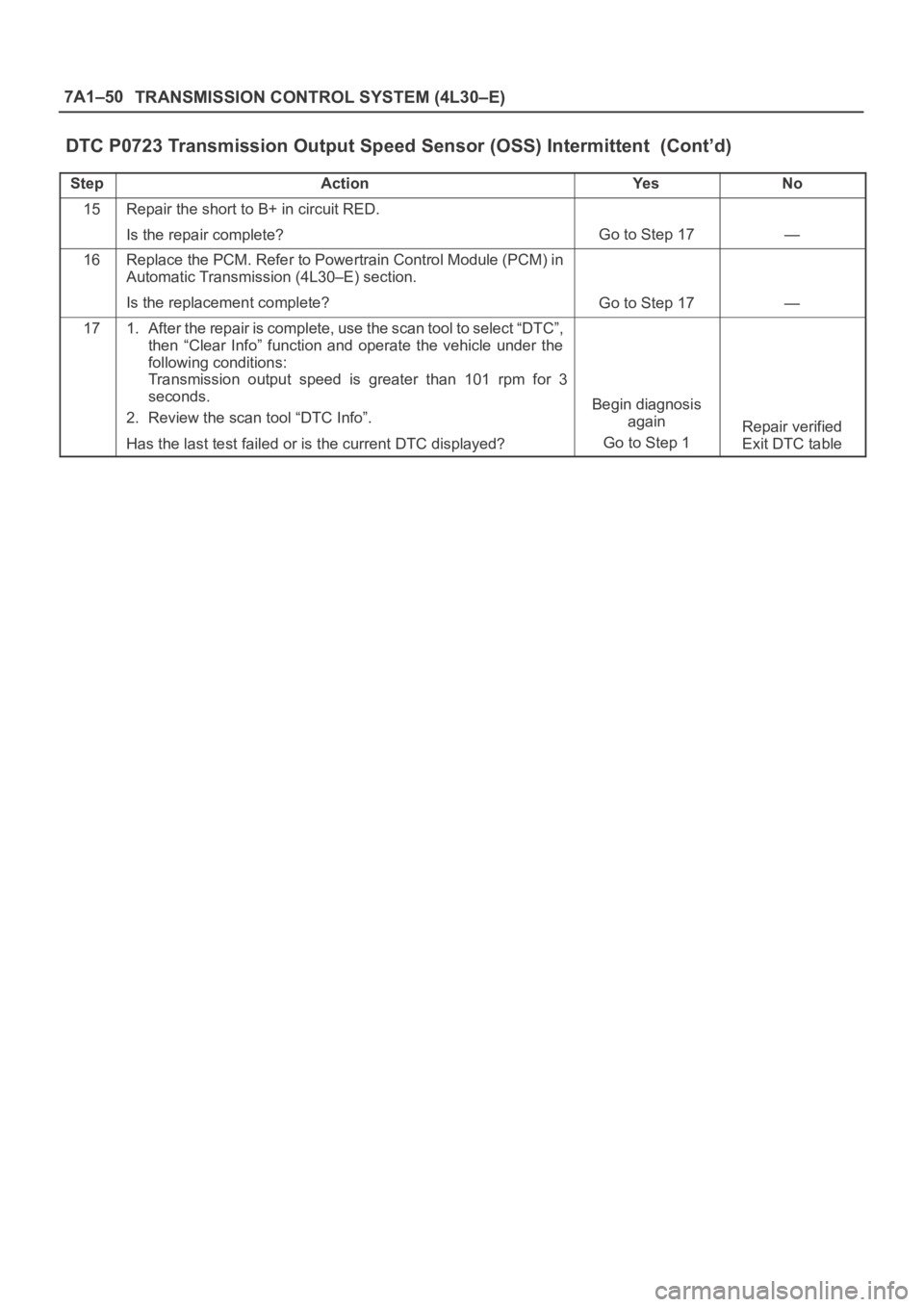
7A1–50
TRANSMISSION CONTROL SYSTEM (4L30–E)
DTC P0723 Transmission Output Speed Sensor (OSS) Intermittent (Cont’d)
StepNo Ye s Action
15Repair the short to B+ in circuit RED.
Is the repair complete?
Go to Step 17—
16Replace the PCM. Refer to Powertrain Control Module (PCM) in
Automatic Transmission (4L30–E) section.
Is the replacement complete?
Go to Step 17—
171. After the repair is complete, use the scan tool to select “DTC”,
then “Clear Info” function and operate the vehicle under the
following conditions:
Transmission output speed is greater than 101 rpm for 3
seconds.
2. Review the scan tool “DTC Info”.
Has the last test failed or is the current DTC displayed?
Begin diagnosis
again
Go to Step 1
Repair verified
Exit DTC table
Page 2300 of 6000
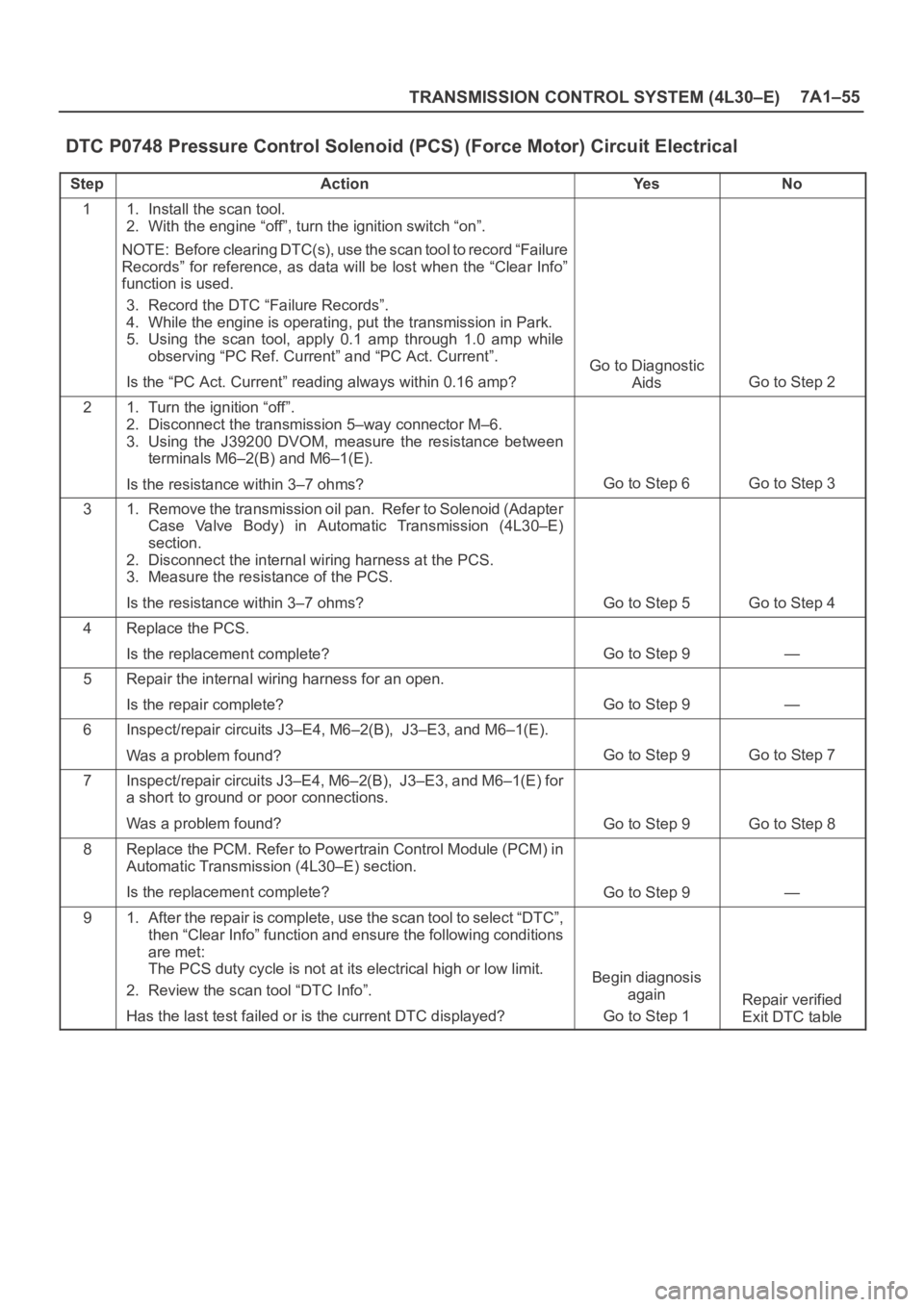
TRANSMISSION CONTROL SYSTEM (4L30–E)7A1–55
DTC P0748 Pressure Control Solenoid (PCS) (Force Motor) Circuit Electrical
StepActionYe sNo
11. Install the scan tool.
2. With the engine “off”, turn the ignition switch “on”.
NOTE: Before clearing DTC(s), use the scan tool to record “Failure
Records” for reference, as data will be lost when the “Clear Info”
function is used.
3. Record the DTC “Failure Records”.
4. While the engine is operating, put the transmission in Park.
5. Using the scan tool, apply 0.1 amp through 1.0 amp while
observing “PC Ref. Current” and “PC Act. Current”.
Is the “PC Act. Current” reading always within 0.16 amp?
Go to Diagnostic
Aids
Go to Step 2
21. Turn the ignition “off”.
2. Disconnect the transmission 5–way connector M–6.
3. Using the J39200 DVOM, measure the resistance between
terminals M6–2(B) and M6–1(E).
Is the resistance within 3–7 ohms?
Go to Step 6Go to Step 3
31. Remove the transmission oil pan. Refer to Solenoid (Adapter
Case Valve Body) in Automatic Transmission (4L30–E)
section.
2. Disconnect the internal wiring harness at the PCS.
3. Measure the resistance of the PCS.
Is the resistance within 3–7 ohms?
Go to Step 5Go to Step 4
4Replace the PCS.
Is the replacement complete?
Go to Step 9—
5Repair the internal wiring harness for an open.
Is the repair complete?
Go to Step 9—
6Inspect/repair circuits J3–E4, M6–2(B), J3–E3, and M6–1(E).
Was a problem found?
Go to Step 9Go to Step 7
7Inspect/repair circuits J3–E4, M6–2(B), J3–E3, and M6–1(E) for
a short to ground or poor connections.
Was a problem found?
Go to Step 9Go to Step 8
8Replace the PCM. Refer to Powertrain Control Module (PCM) in
Automatic Transmission (4L30–E) section.
Is the replacement complete?
Go to Step 9—
91. After the repair is complete, use the scan tool to select “DTC”,
then “Clear Info” function and ensure the following conditions
are met:
The PCS duty cycle is not at its electrical high or low limit.
2. Review the scan tool “DTC Info”.
Has the last test failed or is the current DTC displayed?
Begin diagnosis
again
Go to Step 1
Repair verified
Exit DTC table
Page 2303 of 6000
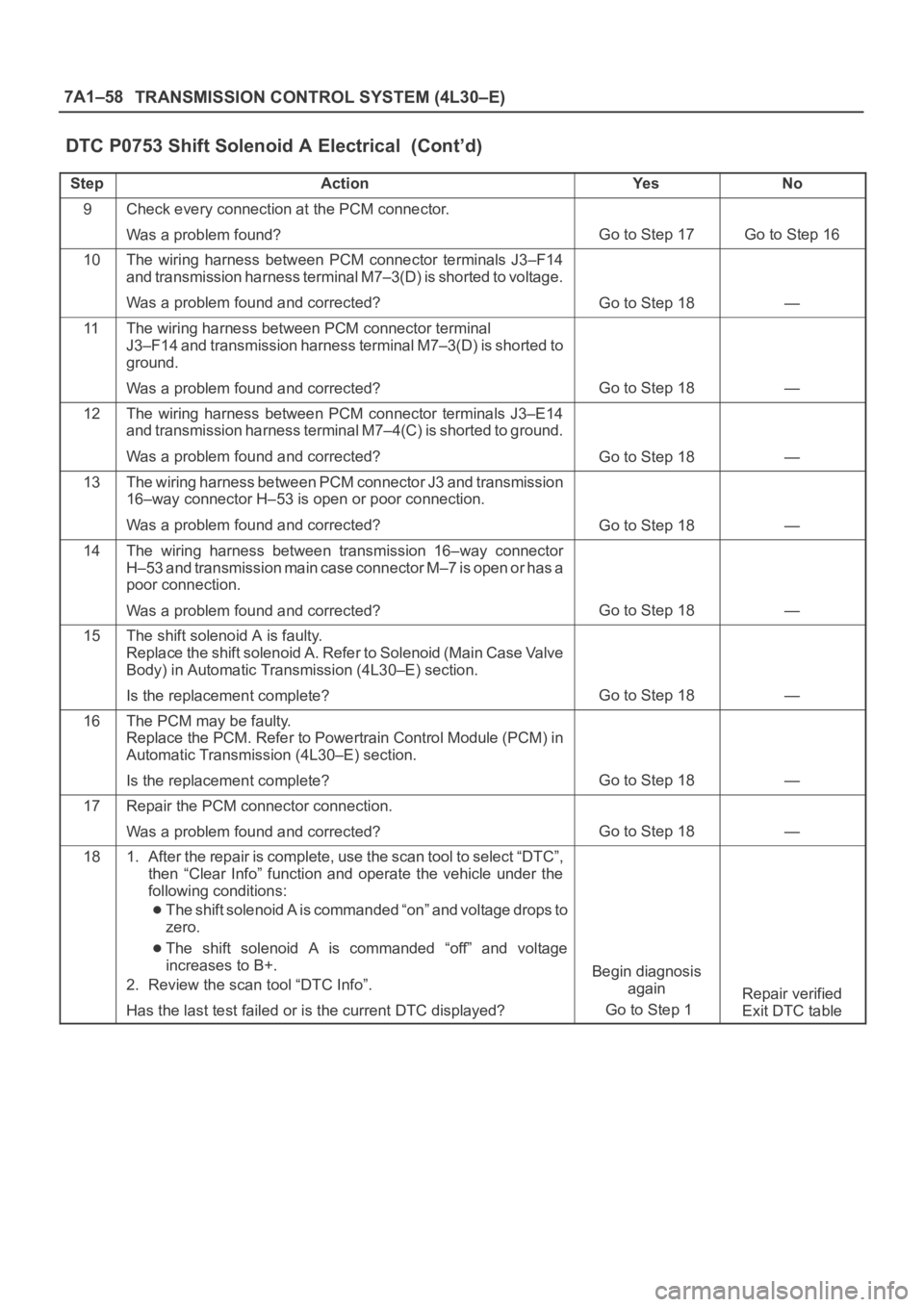
7A1–58
TRANSMISSION CONTROL SYSTEM (4L30–E)
DTC P0753 Shift Solenoid A Electrical (Cont’d)
StepNo Ye s Action
9Check every connection at the PCM connector.
Was a problem found?
Go to Step 17Go to Step 16
10The wiring harness between PCM connector terminals J3–F14
and transmission harness terminal M7–3(D) is shorted to voltage.
Was a problem found and corrected?
Go to Step 18—
11The wiring harness between PCM connector terminal
J3–F14 and transmission harness terminal M7–3(D) is shorted to
ground.
Was a problem found and corrected?
Go to Step 18—
12The wiring harness between PCM connector terminals J3–E14
and transmission harness terminal M7–4(C) is shorted to ground.
Was a problem found and corrected?
Go to Step 18—
13The wiring harness between PCM connector J3 and transmission
16–way connector H–53 is open or poor connection.
Was a problem found and corrected?
Go to Step 18—
14The wiring harness between transmission 16–way connector
H–53 and transmission main case connector M–7 is open or has a
poor connection.
Was a problem found and corrected?
Go to Step 18—
15The shift solenoid A is faulty.
Replace the shift solenoid A. Refer to Solenoid (Main Case Valve
Body) in Automatic Transmission (4L30–E) section.
Is the replacement complete?
Go to Step 18—
16The PCM may be faulty.
Replace the PCM. Refer to Powertrain Control Module (PCM) in
Automatic Transmission (4L30–E) section.
Is the replacement complete?
Go to Step 18—
17Repair the PCM connector connection.
Was a problem found and corrected?
Go to Step 18—
181. After the repair is complete, use the scan tool to select “DTC”,
then “Clear Info” function and operate the vehicle under the
following conditions:
The shift solenoid A is commanded “on” and voltage drops to
zero.
The shift solenoid A is commanded “off” and voltage
increases to B+.
2. Review the scan tool “DTC Info”.
Has the last test failed or is the current DTC displayed?
Begin diagnosis
again
Go to Step 1
Repair verified
Exit DTC table
Page 2305 of 6000
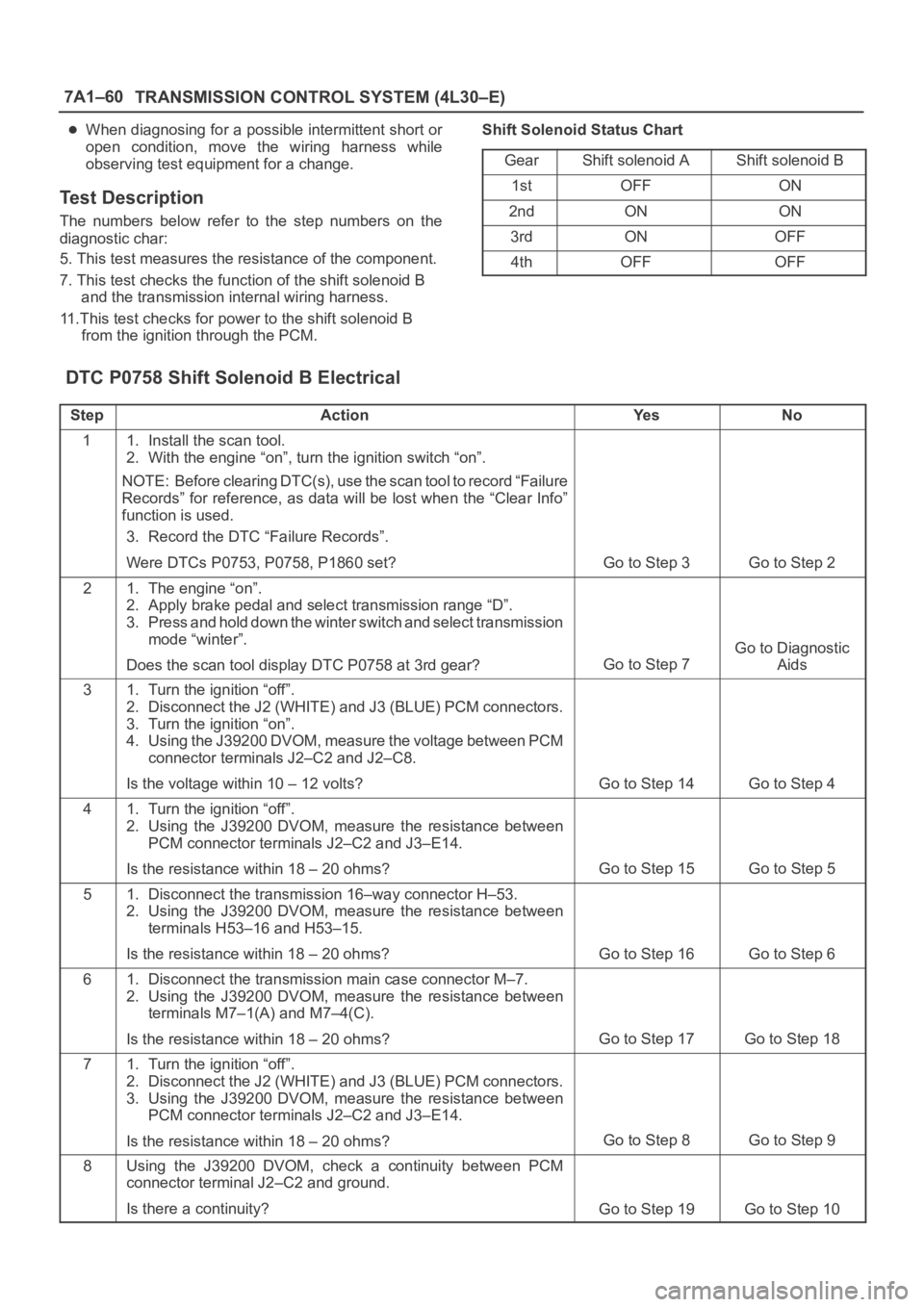
7A1–60
TRANSMISSION CONTROL SYSTEM (4L30–E)
When diagnosing for a possible intermittent short or
open condition, move the wiring harness while
observing test equipment for a change.
Test Description
The numbers below refer to the step numbers on the
diagnostic char:
5. This test measures the resistance of the component.
7. This test checks the function of the shift solenoid B
and the transmission internal wiring harness.
11.This test checks for power to the shift solenoid B
from the ignition through the PCM.Shift Solenoid Status Chart
Gear
Shift solenoid AShift solenoid B
1stOFFON
2ndONON
3rdONOFF
4thOFFOFF
DTC P0758 Shift Solenoid B Electrical
StepActionYe sNo
11. Install the scan tool.
2. With the engine “on”, turn the ignition switch “on”.
NOTE: Before clearing DTC(s), use the scan tool to record “Failure
Records” for reference, as data will be lost when the “Clear Info”
function is used.
3. Record the DTC “Failure Records”.
Were DTCs P0753, P0758, P1860 set?
Go to Step 3Go to Step 2
21. The engine “on”.
2. Apply brake pedal and select transmission range “D”.
3. Press and hold down the winter switch and select transmission
mode “winter”.
Does the scan tool display DTC P0758 at 3rd gear?
Go to Step 7
Go to Diagnostic
Aids
31. Turn the ignition “off”.
2. Disconnect the J2 (WHITE) and J3 (BLUE) PCM connectors.
3. Turn the ignition “on”.
4. Using the J39200 DVOM, measure the voltage between PCM
connector terminals J2–C2 and J2–C8.
Is the voltage within 10 – 12 volts?
Go to Step 14Go to Step 4
41. Turn the ignition “off”.
2. Using the J39200 DVOM, measure the resistance between
PCM connector terminals J2–C2 and J3–E14.
Is the resistance within 18 – 20 ohms?
Go to Step 15Go to Step 5
51. Disconnect the transmission 16–way connector H–53.
2. Using the J39200 DVOM, measure the resistance between
terminals H53–16 and H53–15.
Is the resistance within 18 – 20 ohms?
Go to Step 16Go to Step 6
61. Disconnect the transmission main case connector M–7.
2. Using the J39200 DVOM, measure the resistance between
terminals M7–1(A) and M7–4(C).
Is the resistance within 18 – 20 ohms?
Go to Step 17Go to Step 18
71. Turn the ignition “off”.
2. Disconnect the J2 (WHITE) and J3 (BLUE) PCM connectors.
3. Using the J39200 DVOM, measure the resistance between
PCM connector terminals J2–C2 and J3–E14.
Is the resistance within 18 – 20 ohms?
Go to Step 8Go to Step 9
8Using the J39200 DVOM, check a continuity between PCM
connector terminal J2–C2 and ground.
Is there a continuity?
Go to Step 19Go to Step 10
Page 2306 of 6000
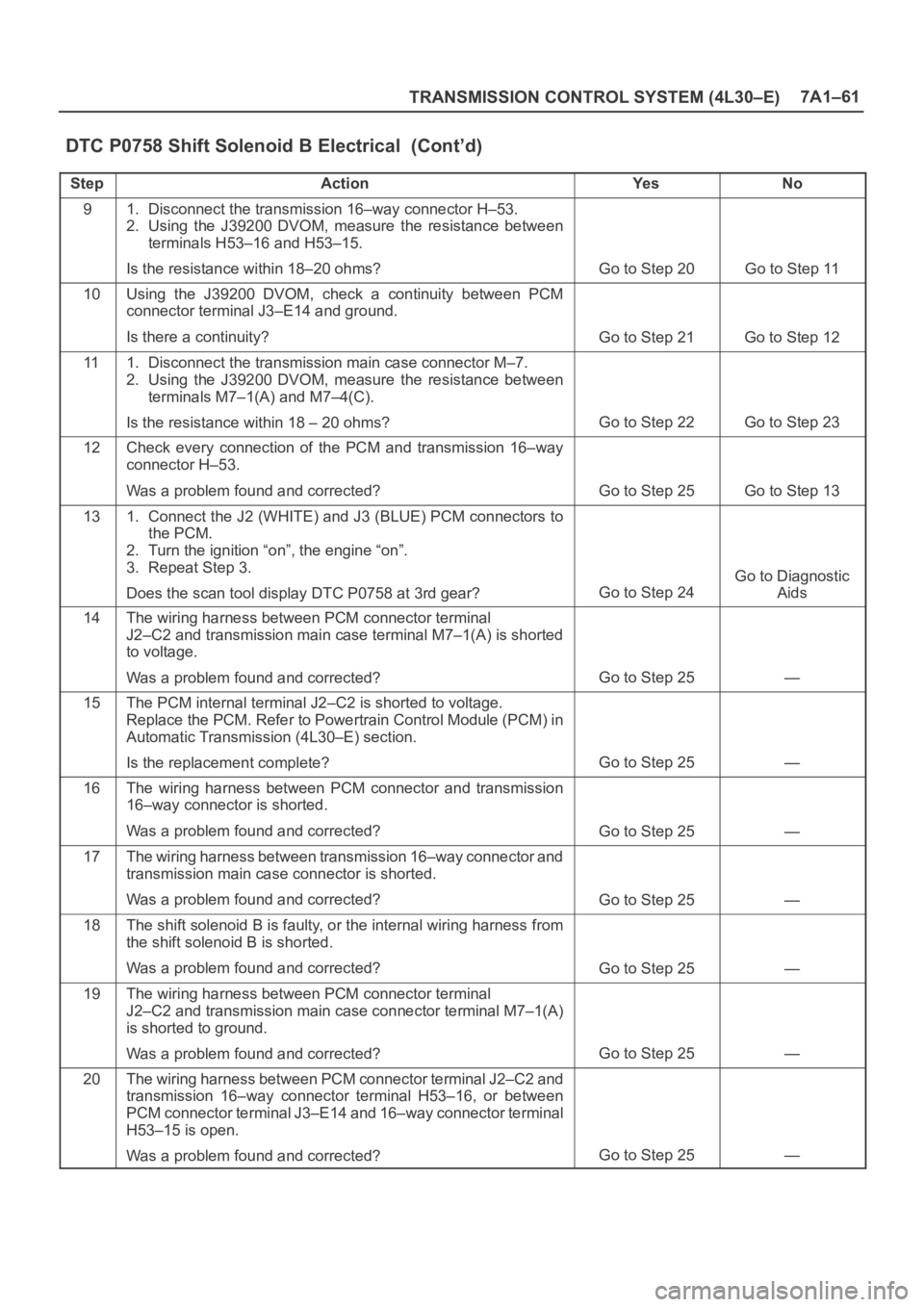
TRANSMISSION CONTROL SYSTEM (4L30–E)7A1–61
DTC P0758 Shift Solenoid B Electrical (Cont’d)
StepNo Ye s Action
91. Disconnect the transmission 16–way connector H–53.
2. Using the J39200 DVOM, measure the resistance between
terminals H53–16 and H53–15.
Is the resistance within 18–20 ohms?
Go to Step 20Go to Step 11
10Using the J39200 DVOM, check a continuity between PCM
connector terminal J3–E14 and ground.
Is there a continuity?
Go to Step 21Go to Step 12
111. Disconnect the transmission main case connector M–7.
2. Using the J39200 DVOM, measure the resistance between
terminals M7–1(A) and M7–4(C).
Is the resistance within 18 – 20 ohms?
Go to Step 22Go to Step 23
12Check every connection of the PCM and transmission 16–way
connector H–53.
Was a problem found and corrected?
Go to Step 25Go to Step 13
131. Connect the J2 (WHITE) and J3 (BLUE) PCM connectors to
the PCM.
2. Turn the ignition “on”, the engine “on”.
3. Repeat Step 3.
Does the scan tool display DTC P0758 at 3rd gear?
Go to Step 24
Go to Diagnostic
Aids
14The wiring harness between PCM connector terminal
J2–C2 and transmission main case terminal M7–1(A) is shorted
to voltage.
Was a problem found and corrected?
Go to Step 25—
15The PCM internal terminal J2–C2 is shorted to voltage.
Replace the PCM. Refer to Powertrain Control Module (PCM) in
Automatic Transmission (4L30–E) section.
Is the replacement complete?
Go to Step 25—
16The wiring harness between PCM connector and transmission
16–way connector is shorted.
Was a problem found and corrected?
Go to Step 25—
17The wiring harness between transmission 16–way connector and
transmission main case connector is shorted.
Was a problem found and corrected?
Go to Step 25—
18The shift solenoid B is faulty, or the internal wiring harness from
the shift solenoid B is shorted.
Was a problem found and corrected?
Go to Step 25—
19The wiring harness between PCM connector terminal
J2–C2 and transmission main case connector terminal M7–1(A)
is shorted to ground.
Was a problem found and corrected?
Go to Step 25—
20The wiring harness between PCM connector terminal J2–C2 and
transmission 16–way connector terminal H53–16, or between
PCM connector terminal J3–E14 and 16–way connector terminal
H53–15 is open.
Was a problem found and corrected?
Go to Step 25—